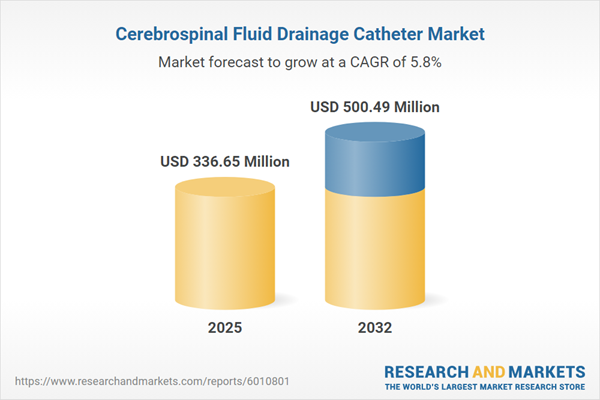Speak directly to the analyst to clarify any post sales queries you may have.
The cerebrospinal fluid drainage catheter market is rapidly evolving, driven by increasing demands for neurotechnology integration, robust device management, and improved patient safety. This shift requires healthcare leaders to adopt forward-focused procurement and operational strategies.
Cerebrospinal Fluid Drainage Catheter Market Snapshot
The global cerebrospinal fluid drainage catheter market demonstrated measurable growth in 2024, reaching USD 318.26 million and moving toward USD 336.65 million in 2025. Forecasts project a value of USD 500.49 million by 2032, supported by a compound annual growth rate of 5.82%.
This upward trajectory aligns closely with accelerating technology adoption in neurological care, the drive for seamless workflow integration, and ongoing improvements in product engineering. Healthcare providers worldwide position these catheters as essential components of neuromedical infrastructure, responding to the needs of diverse patient groups through modernized care models.Cerebrospinal Fluid Drainage Catheter Market: Scope & Segmentation
- Product Types: Includes lumbar catheters, spinal epidural catheters, and ventricular catheters engineered for both temporary intervention and ongoing management, enabling a range of neurosurgical and neurological applications through enhanced device accuracy and lasting durability.
- Applications: Encompasses cerebrospinal fluid management, hydrocephalus therapy, intracranial pressure monitoring, and intrathecal drug delivery. These devices serve acute, chronic, and preventive neurological care, delivering standardized treatment protocols and supporting better clinical consistency across varied patient populations.
- End Uses: Utilized by hospitals, ambulatory surgery centers, and clinics to improve case management, operational efficiency, and quality of care across both urban medical hubs and distributed community networks.
- Materials: Biocompatible polyethylene, polyurethane, and silicone are the core materials, helping to ensure safety, product reliability, and compliance with international healthcare standards.
- Distribution Channels: Direct procurement, distributor alliances, and digital supply pathways facilitate adaptable sourcing and shorter delivery cycles, supporting reliable inventory management and fulfilling both standard and urgent procurement requirements.
- Geographical Regions: The market spans the Americas, Europe, Middle East & Africa, and Asia-Pacific. Regional distinctions, including regulatory factors, healthcare infrastructure, and technology uptake, influence the magnitude of market opportunity for local and global suppliers.
- Profiled Companies: Leading the competitive landscape are Medtronic plc, B. Braun Melsungen AG, ICU Medical, Teleflex Incorporated, Becton, Dickinson and Company, Cook Medical, Baxter International, AngioDynamics, Merit Medical Systems, and Integra LifeSciences Holdings, all prioritizing product innovation and adaptive service models.
Cerebrospinal Fluid Drainage Catheter Market: Key Takeaways
- Integration of sensors and artificial intelligence is advancing therapy personalization and strengthening clinical decision support for neurological treatments.
- Manufacturers and healthcare providers are responding to heightened regulatory expectations with updated quality assurance, thorough auditing, and careful oversight throughout the device lifecycle.
- Digital health advancements and movement toward minimally invasive catheter placement techniques are refining care workflows and improving procedural efficiencies for critical patient populations.
- Procurement and supply teams are adopting diversified sourcing and resilient supply chain strategies to reduce exposure to supply fluctuations and enable continuity under varying global trade conditions.
- Catheter material science continues to evolve, delivering improved durability and safety alignment with international clinical protocols and shifting patient care needs.
- Market entry strategies are shaped by variations in regional reimbursement models and healthcare infrastructure readiness; Asia-Pacific is witnessing notable expansion in both technology uptake and procedural scalability.
Tariff Impact on Cost Structure and Sourcing Strategies
Recent changes to United States tariffs affecting elastomeric and specialized catheter components are prompting manufacturers to adjust sourcing and production strategies, often by relocating operations closer to end-user markets. Enhanced supplier partnerships, flexible contracting, and dynamic sourcing models help procurement departments maintain operational efficiency despite evolving trade policies and international production trends.
Methodology & Data Sources
This report integrates insights from direct interviews with clinical leaders and procurement executives, supported by rigorous market analytics and evidence from peer-reviewed research. The combined approach equips stakeholders with clear, actionable intelligence about both current market dynamics and ongoing industry shifts.
Why This Report Matters
- Provides guidance for aligning procurement, operational practices, and quality standards with advancing neurological care technology and regulatory frameworks.
- Supports executive decision-making on technology adoption, evolving supply chains, and strategic resource allocation to reinforce long-term clinical and organizational growth.
- Clarifies market evolution, technological innovations, and regional growth dynamics, allowing stakeholders to optimize investments and boost organizational agility.
Conclusion
Long-term market success depends on ongoing innovation, resilient supply strategies, and responsiveness to regulatory and clinical advancements. Organizations that prioritize technology-driven agility are best equipped to create value and sustain growth.
Additional Product Information:
- Purchase of this report includes 1 year online access with quarterly updates.
- This report can be updated on request. Please contact our Customer Experience team using the Ask a Question widget on our website.
Table of Contents
3. Executive Summary
4. Market Overview
7. Cumulative Impact of Artificial Intelligence 2025
Companies Mentioned
The companies profiled in this Cerebrospinal Fluid Drainage Catheter market report include:- Medtronic plc
- B. Braun Melsungen AG
- ICU Medical, Inc.
- Teleflex Incorporated
- Becton, Dickinson and Company
- Cook Medical, LLC
- Baxter International Inc.
- AngioDynamics, Inc.
- Merit Medical Systems, Inc.
- Integra LifeSciences Holdings Corporation
Table Information
| Report Attribute | Details |
|---|---|
| No. of Pages | 192 |
| Published | October 2025 |
| Forecast Period | 2025 - 2032 |
| Estimated Market Value ( USD | $ 336.65 Million |
| Forecasted Market Value ( USD | $ 500.49 Million |
| Compound Annual Growth Rate | 5.8% |
| Regions Covered | Global |
| No. of Companies Mentioned | 11 |









